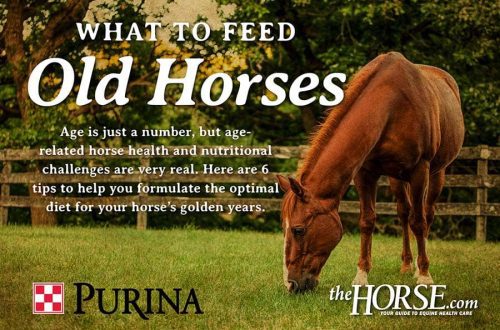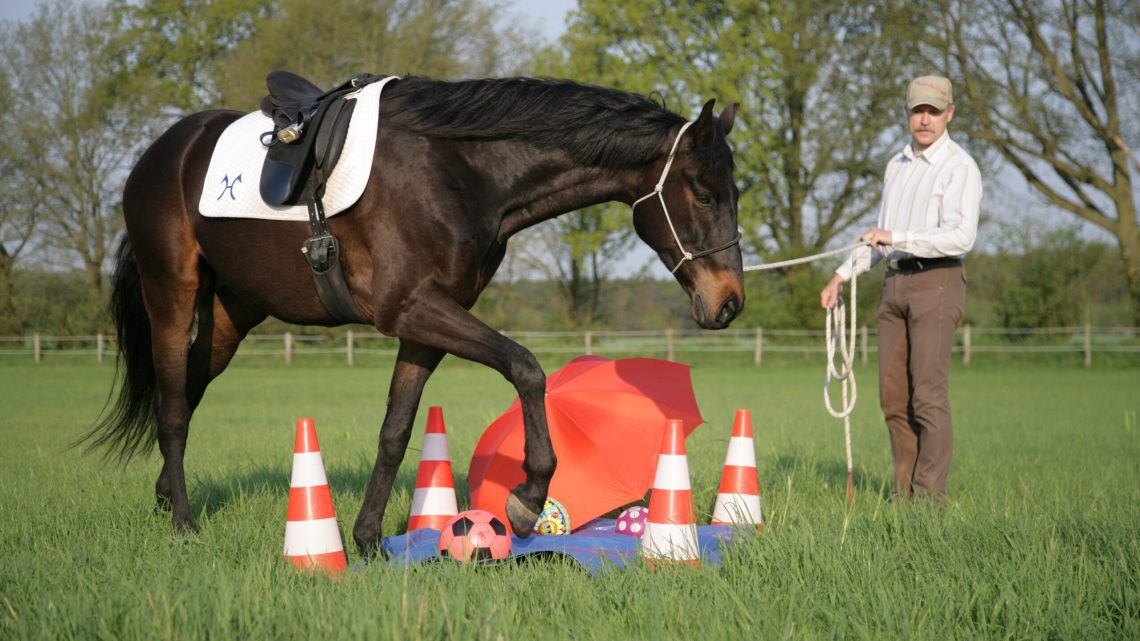
Working with a horse on the ground: types and methods
Working with a horse on the ground: types and methods
Working with a horse on the ground covers a wide range of activities and requires specific skills from both horse and handler. In its simplest form, work on the ground begins with pulling on the foal and includes all subsequent manipulations with the horse from the ground, which continue throughout his life – whether it is free work, in hands, on a lunge or on the reins.
Work on horse manners. Horse control from the ground
There are no shortcuts in the world of good coaching. Training takes time and constant steady work to ensure the necessary mental and physical development of the horse – and it all starts with work from the ground.
The horse must be sociable, polite and show due respect for the person, while at the same time retaining its character and personality. Otherwise, the simplest tasks will become difficult for her, and when the training under the saddle begins, the foundation of her “education” will either be very modest or non-existent.
Even at the moment of communication with the horse on earth, it is necessary to introduce basic rules and boundaries, and this is by no means achieved by establishing dominance over the horse. We must let her figure out what behavioral options are most comfortable and permissible for her. The horse should be encouraged to follow the right path by guiding it in a positive and confident manner.
By establishing control from the ground, by teaching the horse how to communicate with a person, we teach the horse to focus all his attention on us, respond to our signals, show respect, trust, consider us worthy of following. This is the basis on which further training will be built.
In reality, the training of a horse actually begins from the moment of its birth, but we constantly encounter horses that do not have basic social skills (manners), do not know how to behave in the stable and in the paddock. They cannot be put on junctions, you cannot take a leg for unhooking, they do not walk well on a lead rope, they do not want to stand still, they do not know how to behave properly next to a person – this list is endless.
An ill-bred horse is potentially dangerous. It is very important that the horse responds to the requests of the person who is nearby; obedience skills and a willingness to cooperate are vital in dangerous situations and can even draw the line between life and death, such as in the event of a stable fire.
Stallions especially need good manners. This is for their own safety and the safety of others, as stallions easily become “impenetrable” when testosterone hits them in the head…
Work from the ground
Working with the horse in order to establish the foundations of communication or strengthen them, if the horse is already familiar with such requirements, allows us and it to get to know each other better, the horse begins to trust the person more, realizes that he is not a threat to him. We do this by teaching the horse to respond to our body language and movement signals, and by working with the natural influences and energies contained in our and her bodies.
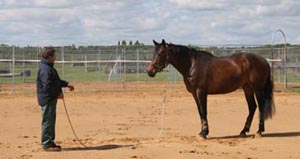
The young mare is completely focused on the person. She has her attention focused on him, but most importantly, she is relaxed in anticipation of his signals. Until another signal is given, the horse must remain in place without attempting to move, kick or look around.
With progress in training, such classes can be held in freedom (without a lead or cord).
When the coach asks the mare to come to him, she executes the command and immediately receives a reward.
Even the simplest exercises on the ground require a lot of concentration from a horse, especially a young one, so at first we work with short repetitions. Note also that young horses get tired very quickly.
During training, we constantly reward and calm the horse, regardless of his age. Remember that it’s not just a young horse that needs to work from the ground – often older horses need to be reminded of good manners.
By establishing basic control from the ground and teaching the horse manners, we can move on to other stages of training with ease.
Work in hand
Hand work is a derivative of learning basic control from the ground.
Introducing the horse to the saddle
The bridle should not contribute to the emergence of any problems, if we do everything patiently and calmly. Of course, the horse needs to be given time to adjust to the new “weird” sensations. Bridle problems only arise when there is rough and insensitive handling of a young horse.
When introducing a young horse to saddle and saddle, difficulties can arise because the horse may not like the way something wraps around its body. She may follow an instinct to get rid of what she sees as a threat to her safety. And it’s natural.
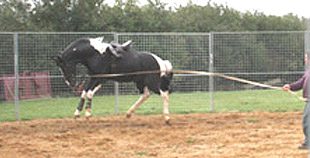
This young horse has been trained to handle well, so familiarity with the saddle did not cause him any problems – he is just young and childish, playing. However, when the horse behaves like him, care must be taken not to tug on his mouth. This is the reason we don’t attach the lead to the snaffle until the horse is calm.
Some horses have a habit of lunging if they have had a break from work, but it is important to rule out other possible causes of this behavior (such as physical discomfort).
The trainer’s role is very important at this stage, as the cord must not block the horse’s forward movement. The experience of a young horse should not be made negative by lunging, yelling or frightening it with a barrage.
Work in freedom
Freewheeling is an invaluable method of training from the ground, as the horse works independently of the person. Direction, speed and rhythm commands are given only through the coach’s body language, voice and movements. It is important that the horse has already mastered the basics of basic control from the ground – and not only that he will already be familiar with all the signals. The main thing is that the horse will not be embarrassed or embarrassed when asked to do something that he does not fully understand.
Working in freedom without the influence of the rider, the horse becomes more confident. She thinks that she copes with the tasks on her own.
We include outdoor work in the training of all the horses we train as it allows us to monitor progress and observe the horse in the wild. We see how she moves, how she accepts what she is taught, and so on. Working with a young horse in the wild, we allow him to fully accept and learn to wear a saddle, accept a snaffle before starting the next stages of training.
At first, we cannot expect the horse to respond perfectly to all our commands – everything will happen gradually. Over time, the horse will begin to respond to the most subtle hints. Free work allows the young horse to get used to the saddle and snaffle. And for an older horse, or a horse in need of rehabilitation exercise, running free is the ideal preparation before riding on the reins.
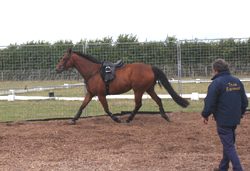
Without the intervention of additional devices, this horse carried the nose high and used the muscles of the lower neck. The photo shows that her neck has no muscle tone and is shapeless. Nothing happens behind the saddle – there is no movement, no activity of the hind legs.
Under the saddle, it will go on the front, will not move from the leg and will be quite “wooden”. Such horses encourage many riders to constantly change gear in an attempt to remedy the situation, rather than getting to the root of the problem. Using his body in this way, or rather not using his body, this horse will never develop the right muscles to support him, let alone the rider’s weight.
After evaluating the horse, we decided to use interchanges and observe his reaction – whether it be positive or negative.

Reinouches should be used with extreme caution, as it is very easy to fit them incorrectly and “drive” the horse into the right frame, and not encourage him to find this frame on his own. We also need to constantly push the horse forward.
In the case of this horse, everything went well – as you can see, the decoupling does not make him twist his neck and go beyond the vertical. Decoupling simply tells the horse that it will be more comfortable for him to lower his head, thereby rounding and lifting the muscles of the back, and this will make the work more comfortable. Now she looks completely different.
Please note: we do not encourage the use of interchanges!
We use the reins at our sole discretion after we evaluate the horse and the program we plan to work with in order to advance the learning process or address learning issues to the best advantage for the particular horse and rider.
We do not use side reins with young horses that do not yet perceive the snaffle correctly, so as not to damage their delicate mouth.
Decouplings can be helpful when re-training a horse to encourage him to lower his head and accept contact, but again, everything needs to be approached on an individual basis.
Poorly fitted and/or improperly used reins can cause great harm to any horse!
Cord work
By mindlessly lunging a horse, we not only cause tension in the body of an unbalanced or untrained horse, but also develop its muscles incorrectly. How many times have you seen horses lunge with their heads up? What is so good about it?
Lunging goes against much of what we originally taught the young horse about ground manners and ground control, as not only does the lunge “send the horse away” from the trainer, but we also stop controlling it with our strides as it now has to work around. us, and not use our movements as an indication of which direction to go and at what speed. Therefore, we introduce lunging when the horse is relaxed and responding to basic control signals from the ground.
Note for yourself how loose the cord should be!
The horse must respond to the trainer’s signals and commands in order for lunging to be effective. Correct and efficient lunging will allow the horse to move forward with impulsion, rhythm and pace, the horse will gain and improve balance and coordination.
Everyone from time to time works horses on a lunge, but someone just uses a lunge, and someone does it to achieve a specific goal.
Proper lunging skill is a skill that many do not have.
The horse’s attention is completely focused on the trainer, and he responds to his signals. As her butt engages, her withers rise and her neck relaxes.
Observations of this horse lunging can tell us a lot. She actively moves, her neck is stiff – lifted up from the withers instead of stretching forward and bending. The horse does not seek contact and does not seek to make it. Without direct intervention from the trainer, she will continue to trot quite happily, but not learn anything.
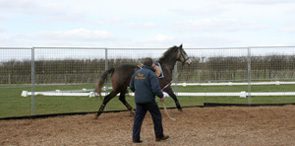
Work with two cords and work on the reins
We are convinced that a horse cannot be trained and trained properly without the inclusion of two lunge work in training, which naturally leads to work on the reins. This is one of the so-called traditional methods of horse work, and it is amazing how much you can teach a horse with it. It is especially good for developing her mouth. Unfortunately, this type of training is unfairly forgotten by many trainers, perhaps because that many people have difficulty using two lines/reins because they don’t have the proper skill.
The advantage of working with two lines is that the lines can be attached to the bridle, so the horse starts looking for contact better and then accepts it. In this case, the second cord, passing around the back of the horse, activates his hind legs. With two lines, it is easier to keep the horse on the right trajectory, working in a circle, and also to prevent him from falling out with his shoulder in or out. And, of course, with two cords in your hands, you can perform flexibility and bending exercises, just as you would do it while sitting in the saddle.
Rein work is much more than just following a horse with the reins going through the loops on the edge, especially if the horse needs to be taught proper contact, lateral movement, engagement of the hindquarters, piaffe, etc. As with horseback riding, the trainer must have a soft, sensitive hand.
Lead work encourages the horse to think, as he must concentrate on the trainer as well as the rider. That is why work on the reins is an important element in the retraining of “spoiled” horses.
It is important at all stages of training a horse to take into account its physical development and mental abilities, as well as gender (mare, stallion, gelding) and breed affiliation. Since, for example, friezes carry their heads high and shorten the frame, care must be taken not to shorten them further!
Working on the reins, you can assess and detect signs of the development of potential resistance at an early stage. Most corrective training is done from the ground, as is work on the more advanced dressage movements, as the horse can be trained without interference from the rider.
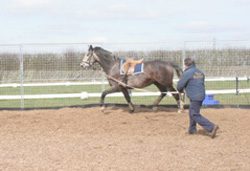
In the early stages of training, this horse was constantly flinging his tongue over the snaffle bit.
To distract her from it and remove the habit, we used the figure eight capsule for a couple of weeks. We also changed the snaffle.
By using the lead behind the horse, the trainer controls and directs the horse, encourages him to start using the muscles that the horse has forgotten or resists engaging in.
Previously, this horse had problems with the correct saddle, so he began to move in a way that minimized discomfort. This is a habit that needs to be eliminated.
At first, the horse’s stride length shortened slightly while he was determined with the idea that he could make contact with the handler’s hand and still move forward.
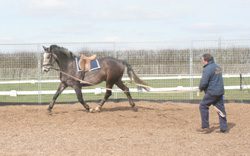
Much better! Although the horse is still holding its head high, it is already actively moving in contact. Continuing the exercises, we will see how she stretches in the neck, raises the withers, stretches the muscles of the topline, which ultimately has a positive effect on their strengthening. The muscles of the hind limbs will continue to be strengthened so that the horse will end up looking like a “whole” horse rather than a “horse in two halves”.
As mentioned earlier, rein work is not just a tool for training a horse. This is the most effective way to correct bad habits from the ground, improve balance, topline (build muscle, etc.) and flexibility.
This gelding was worked in a “hyper-bent” state for a long time before coming to us. As can be seen from the photo, even without contact with the cord, his withers and the back of his head are lowered down.
However, there is a difference between working the horse “deep and round” (not to be confused with Rolkur) and hyperflexion.
Although the horse is lowering and stretching, it is clearly “twisting” the neck. Although its hindquarters step well under the body, the horse does not grab space with its forelegs.
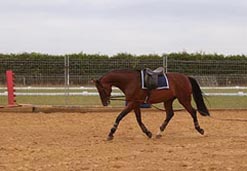
Under the right guidance, the horse “opened” at the neck; her croup is slightly lowered, her hind legs remain active. She now moves in a nice rounded frame that lifts her back muscles, which helps engage her hind legs and stretch her hamstrings.
This topline encourages relaxation between exercises that require more collection. The horse is still short at the front (shoulder tight), but further preparation, including work on the poles, will solve this problem. The reins trainer, as well as the rider, must be able to position the horse’s head in the correct position (when the horse is trained to correctly understand his commands).
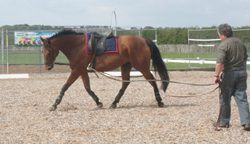
Although the horse in the photo above looks quite good, it doesn’t really show itself very well. But what is wrong? She doesn’t use her back, she doesn’t let her butt down. From it you need to achieve more “rise” and activity.
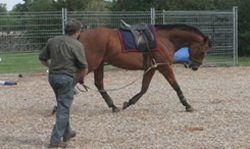
The trainer asks the horse to work “deep and round” (not to be confused with hyperbending when the horse’s nose touches his chest). In this photo, the horse is slightly behind the vertical, but not due to lunge pressure. The horse needs a little more confidence to take the reins in front and below. This type of exercise can be done before riding.
Of course, not every horse behaves well all the time. Our task as trainers is to determine why the horse is behaving this way – is he playing or is a little stagnant, or does not understand what is wanted from him, or is experiencing some kind of discomfort, or is he simply “naughty”. Young horses, especially, often do not behave as expected and can be quite restless.
These photos illustrate the importance of a person working on the reins to be a professional! This behavior is of course unacceptable and must be eliminated before the horse starts to goof off and flash, because he must not conclude that he can do this under the rider!

Working on the reins is also beneficial for adult horses as it can help them maintain flexibility and suppleness. This work is a necessary part of dressage, because you can teach the horse all the movements without burdening him with the weight and influence of the rider, and you can see and check how the horse moves without him.
In the long run, we can remove the saddle or saddle. This is a great way to watch a horse without any restrictions. Even a saddle can lead to changes in the movements of the horse.
During work, the horse should move in a relaxed and rhythmic manner. The proof of this will be her breath. When the horse is “not breathing” he is tense, when he is tense he is not learning.
Remember that this work is not recommended for an inexperienced horse, or if you are unsure or competent in the use of the reins.
The horse should be relaxed and move naturally both at the beginning and at the end of the workout. If the horse is tense even before the start of work, he will not respond correctly during training. Also, if you finish a workout and the horse is tense and unhappy, he may not want to work the next day – and that’s when the negative behavior can show up!
The video below shows the training of a former racehorse. The gelding learns to find her balance on a calm canter. The use of half halts encourages him to work backwards and shift his balance back:
Work on poles
Poles lying on the ground
We dedicate quite a lot of time to lunging poles. This is a very beneficial exercise that encourages joint flexion and stride extension, helps improve balance and coordination, and improves fitness. It also improves concentration and is a valuable training method for horses of all disciplines. There are many different ways to do it, so the training will be interesting and stimulating for the horse – there should be no place for boredom in your classes.
If the horse is especially sensitive to the trainer’s signals, the pole work can be done in the wild.
Work on poles lying on the ground can be carried out both in a “collected” frame and in a “stretched” one – both of these methods are of equal importance and useful, and therefore are included in our work programs.
The poles can be laid out in either a straight line or an arc, with the latter position allowing you to change the length of your horse’s stride without having to adjust the distance.
While we would like to see more activity, this is early training for this young horse. What’s good is that she shows an even stride length and an ideal head position for her fitness level. More importantly, the horse is visibly relaxed and content, as can be seen from his ears.
Compare with the photo below – everything is different there.
This horse is more confident and, although by no means perfect, is much more active in the hocks and shoulders.
When she was able to shift the weight back, she began to move better as she began to push from her butt.
Poles raised above the ground
Working with poles raised off the ground brings great benefits. It can be a great part of a rehabilitation program, especially if the horse has hip problems or needs to strengthen loose ligaments around the joints. This work increases the mobility and flexibility of the joints, and also helps the horse achieve balance and engage the hindquarters.
You can proceed to work with poles raised above the ground only after the horse has figured out the poles lying on the ground. Otherwise, you risk scaring her and possibly stopping her completely.
This horse understands what is being asked of it. This can be seen from the height to which she raised her right leg. However, her movements lack the expression and activity they had while working on the poles lying on the ground.
The horse again lubricates the steps and does not move as we would like – its weight is on the front, not on the back. She tries to rest on the occasion.
After a few repetitions, the movements of the horse begin to acquire some expressiveness – the steps are more springy and in general it is more focused. However, the horse is still a little on the front – this may be due to certain muscle limitations or simply because the horse is not really trying. And this is where the experience of a coach is needed – you need to find out what is the cause, perhaps physical, and find ways to solve the problem.
Demonstration of trainer misbehavior: too much contact has been made, the horse has no choice but to start “overworking” the forehand while the hindquarters begin to fade away.
The trainer should not be deceived into thinking that the horse is doing well because he lifts his legs high above the poles. If you continue to work like this, you can get problems with the muscles.
Already better, but harmony is not fully restored. Higher strides are achieved by more activity in the hocks.
Now the exercise has given the desired effect, the rise of the shoulders and good flexion of the hocks have been achieved; the horse works from the hindquarters, keeping light contact with the reins. The movements are much more expressive.
As the horse becomes more supple and stronger, the horse will be able to lower the croup better as he starts pushing well from the hindquarters, which in turn will lead to more lift and lightening of the forehand.
Fred and Rowena Cook (source); translation by Valeria Smirnova.




